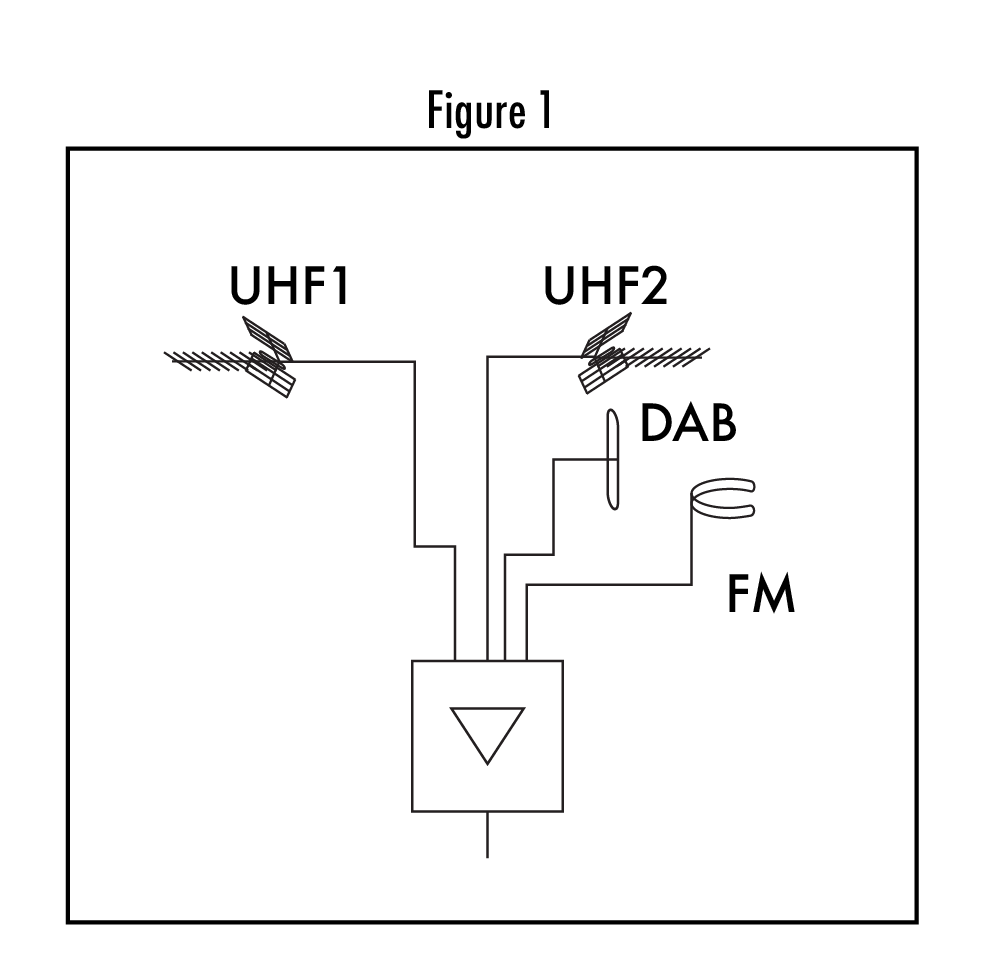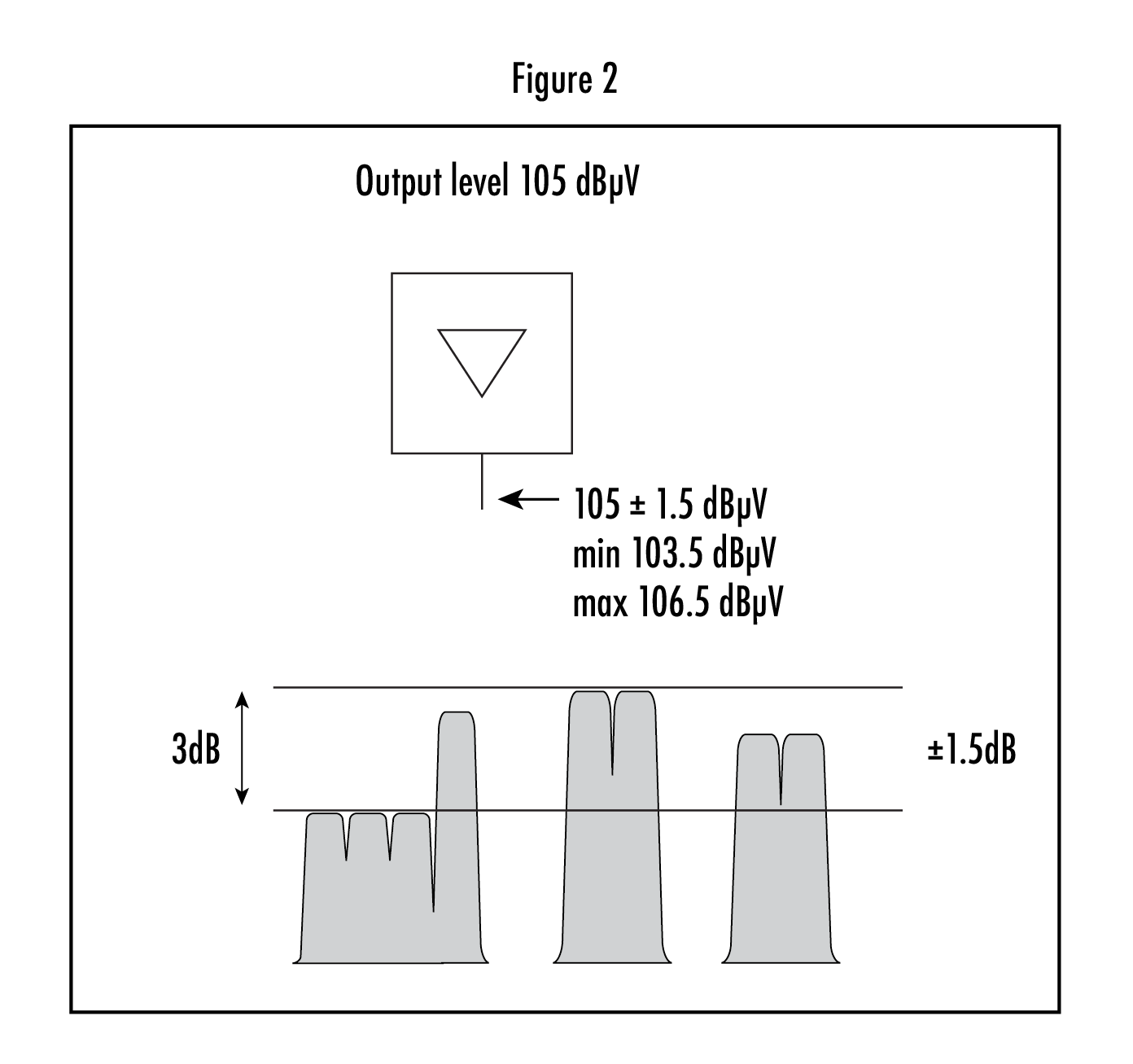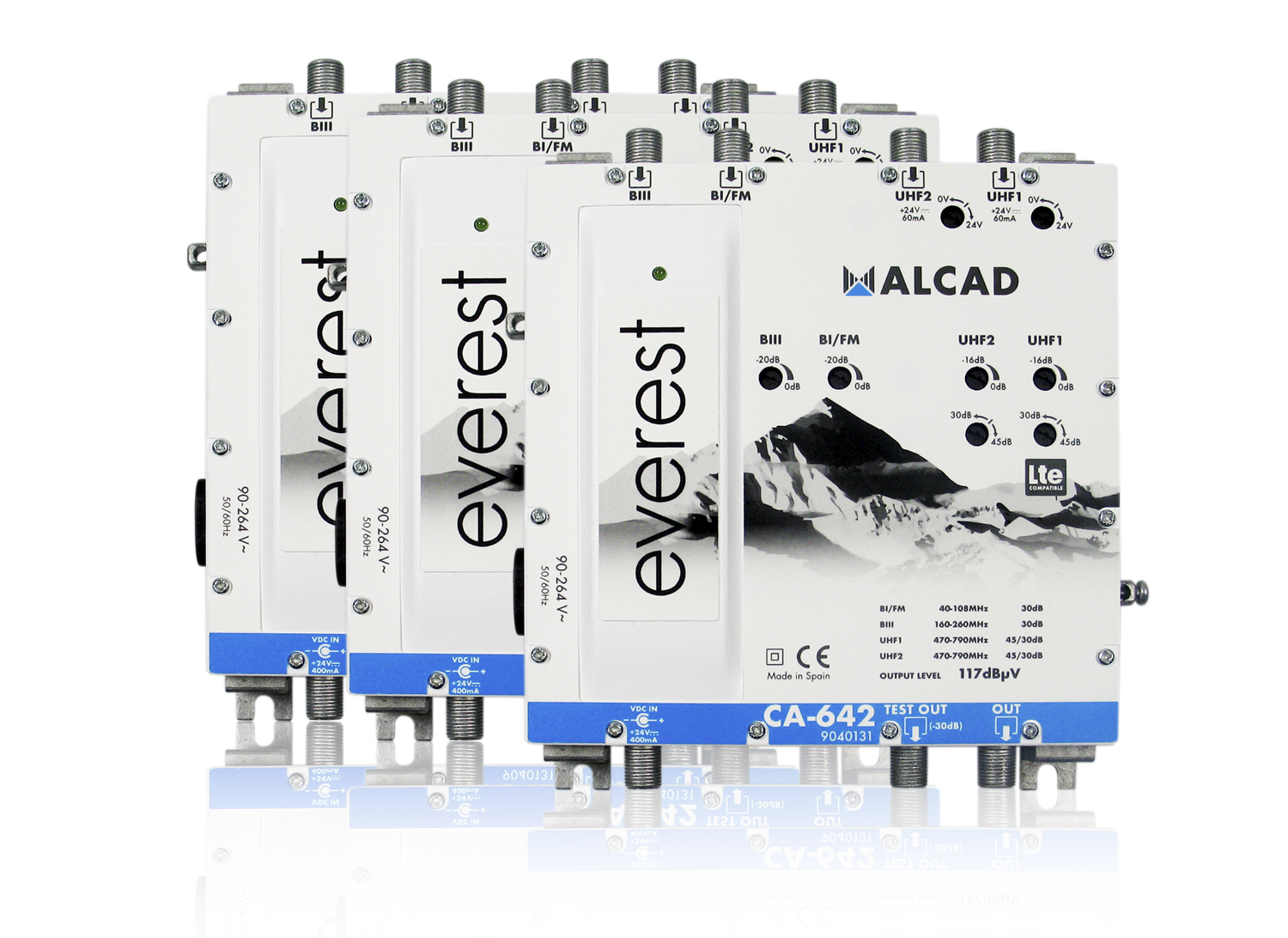
Among the head amplifier equipment available on the market, the most commonly used are single-channel amplifiers, programmable amplifiers and multiband amplifiers. There are also more complex equipment such as regenerators and channel processors.
Points to keep in mind to decide which amplifier we are going to use:
1. We must take into account the number of antennas to install, which depends on the repeaters to receive. Normally, they are one or two antennas for DTT in the UHF band, a DAB digital radio antenna in band III, and an FM antenna in band II. Select a head equipment that has these entries.

Figure 1 - Multiband amplifier and antennas that must be connected
2. The working power of the head-end equipment must be sufficient to distribute the signal to all the TV outlets of the installation. By working power we refer to the real power of the equipment when working with all TV and radio channels. Working at this power, the equipment should not degrade the quality of the TV signal. Neither should we exceed the maximum power allowed by regulations. In large installations the signal can be re-amplified with other equipment to reach all the outlets.
3. The ability to adjust all TV channels to the same power depends on the selectivity. It is necessary to balance the powers of the channels to comply with the regulations, so that the TV receives the signal correctly and to facilitate the distribution of the signal throughout the installation.
4. The gain of the equipment must be sufficient to increase the power of the received channels, until reaching the necessary working power. If the gain is not enough, we will use preamplifiers before the head equipment to add more gain. The use of preamplifiers is common in areas that are far from the repeaters.
5. The regulation requires that the channels at the output of the amplification equipment be balanced. If the channels are not balanced, we must install single-channel amplifiers. But if the channels are received already balanced, we can install multiband or programmable amplifiers. The required balance adjustment is that the difference between channels is not greater than 3 dB.

Figure 2 - Output level of a device with ± 3 dB of adjustment to the output.
6. It is also necessary to consider the filtering of the 4G mobile telephone signals in the LTE800 band and, in the near future, the 5G in the LTE700 band (2nd Digital Dividend). The filtering will be more important the closer we are to the mobile phone repeaters.
Single channel amplifiers vs. Multiband amplifiers. Advantages of each equipment
After analyzing the characteristics of the equipments, we will review the advantages of each equipment:
The single channel amplifiers have a very high selectivity, and this makes them the preferred equipment when the channels are not received balanced. In addition, this selectivity filters the mobile telephone signals in a very efficient way. They are modular equipments that allows the installer to configure the equipment according to the number of channels or groups of channels to receive. These equipments offer a simple adjustment for the professional installer, which have an adjustment for each channel. The maintenance of the equipment is simplified by the fact that it is a modular system.
Multiband amplifiers are basic equipment, very easy to install. They are very compact products and do not require prior assembly. If the installation conditions explained above are met, the adjustment is fast and very simple: it is done with an adjustment for each of the inputs. They have broadband inputs, which avoid the problems of interaction between filters. This problem occurs when the same channel is amplified in several filters at the same time, making it impossible to comply with the balance required by the regulation. They are suitable for any number of channels and it is not necessary to readjust them in case of channel changes.
Do you really need a programmable amplifier?
To make a new TV installation or a renewal, we must decide which head equipment we are going to use. The decision depends on several external factors, which we must consider:
• Compliance with the regulations in force.
• It must be remembered that the 2nd Digital Dividend is scheduled for 2019-2020. This dividend will cut the TV channels available in the UHF band, leaving channels 21 to 48 for TV. This will imply a change in the reception channels.
How to select the amplifier?
The installations in small buildings are ideal for the use of multiband amplifiers. They solve the needs of these facilities in a simple and effective way.
Programmable amplifiers are more complex equipment, often require special programming tools with more complex adjustment procedures. The reduction of the UHF band by the digital dividend has led us to have more groups of adjacent channels and channels closer to each other, and in these situations, the filters of these equipment do not have the necessary selectivity. This generates problems with the adjustment of the channels and we must bear in mind that this situation will worsen with the 2nd Digital Dividend.

Figure 3. Situation with LTE700. Selectivity of the filters and interaction between the filters when adjusting.
When the channels are not received balanced, the best selectivity of the single-channel amplifiers makes it the ideal equipment.
Everest multiband amplifier
The Everest multiband amplifiers range, with amplifiers from one to three UHF band inputs, plus a DAB input in band III for DAB and an FM input.

Amplifiers with gain switching. An additional gain stage is activated by a switch, which increases the gain from 30 to 45 dB. An attenuator is used for the adjustment.
The Everest multiband amplifiers have an internal power supply, but they allow the use of a second redundant power supply to reduce maintenance outputs. If there are strong storms and the power supply breaks down, adding an external power supply maximizes the ease and and fixing time.
More information in MULTIMEDIA TV - Signal processing - multiband amplifiers

More information
